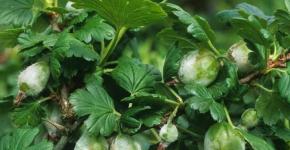Saxifrage for rocky gardens
High in the mountains among the rocks, in narrow crevices and cracks of stones, tiny bushes of plants make their way to the light. They form small curtains, similar to dense pads. Some of them are like small lumps of bright green, others resemble or.
But shoots begin to rise from the dense mass of leaves, at the ends of which buds are visible. When they open, the whole curtain changes: from green or bluish, it becomes purple-pink, sometimes white or yellow. That's how they bloom.
An extensive genus of saxifrage belongs to the Saxifrage family ( Saxifragaceae) and has from 370 to 440 species according to various sources. They are distributed mainly in the Northern Hemisphere, some representatives are found in Africa - in the highlands of tropical countries.
Such an unusual name of the plant was received from the Latin words saxum- rock and fragere- to break, and it speaks of the extraordinary ability of saxifrage to survive in the most inaccessible corners, among stones, in rock crevices. At the same time, they grow into wide curtains and bloom beautifully.

Botanical description
Almost all representatives of the genus are herbaceous perennials, the height of which varies from 5 to 70 cm. They have rhizomes and basal rosettes of leaves, grow to the sides, forming sods: sometimes very dense, similar to hemispheres, sometimes loose.Depending on the species, there are leaves of various shapes (oval, heart-shaped, pinnate, diamond-shaped), they are smooth, leathery, pubescent, painted in dark green or gray, bluish, silvery shades. On the surface of the plant, you can often see a grayish calcareous coating that they secrete.

The flowers are medium-sized, five-petal, have the correct star shape. There are solitary, but often collected in small inflorescences in the form of a panicle, the color depends on the variety (white, pink, yellow). Flowering is usually long.
Arends' saxifrage
Arends' saxifrage (Saxifraga x arendsii)- the most common species among flower growers. Rather, it is an interspecific hybrid belonging to the group of bryophytes saxifrage. Very pretty plant 10-20 cm tall, forms semicircular bright green pads. Blooms in late spring - early summer.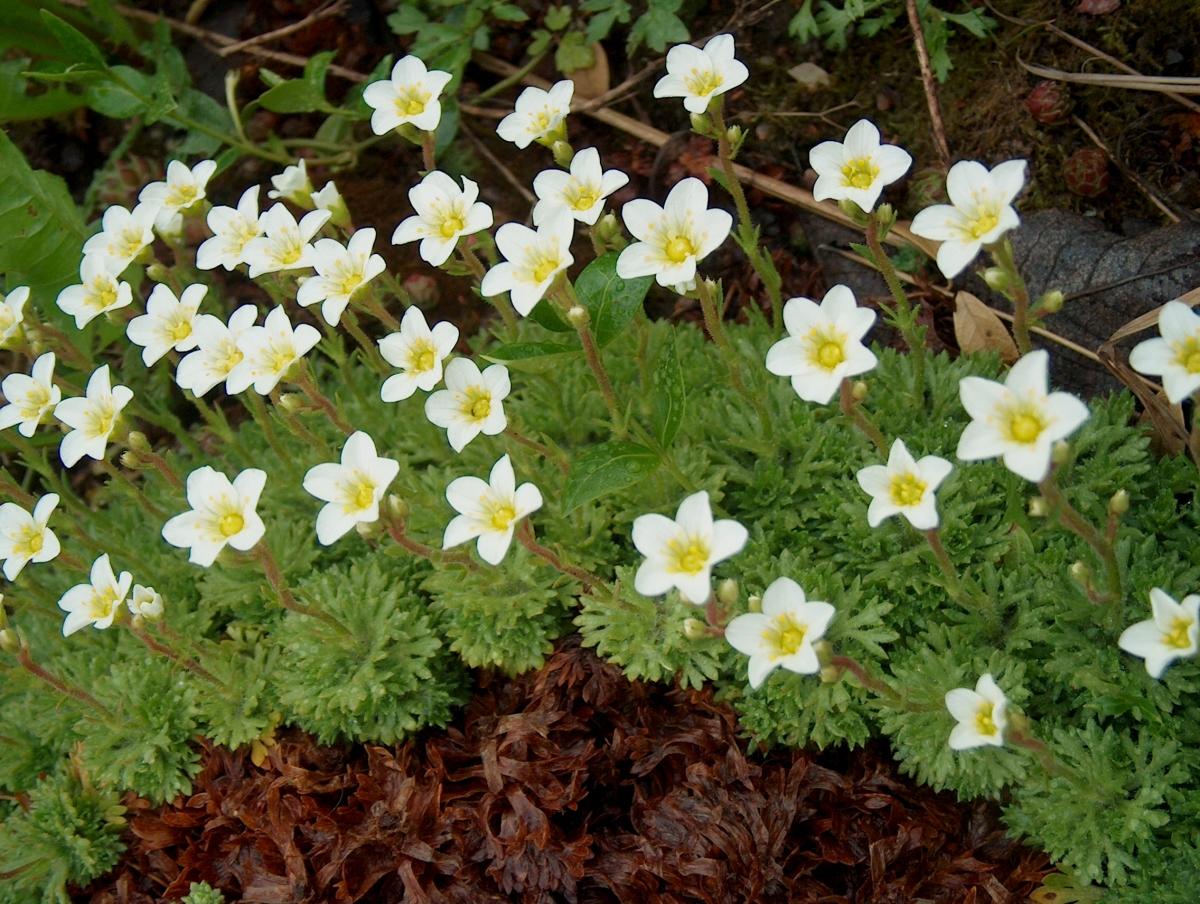
During flowering, the entire curtain is covered with pink or white flowers on tall pedicels. Winter-hardy and unpretentious species, grows quite quickly under good conditions. He does not like drying out, with a lack of moisture, bald spots may appear, which eventually overgrow. Excessive moisture may cause partial damping.
In care, the view is undemanding, the main thing is not to allow the plants to dry out. Grown outdoors, but partial shade is acceptable. The soil prefers loose, moist. It is necessary to transplant and rejuvenate plants no more than once every 4-5 years.
Interesting varieties:
- Purpurmantel. The flowers are purple-pink in color, the height of the plant is not more than 20 cm.
- "Blutenteppich" has bright red flowers, the plant is stunted - up to 15 cm in height.
- "Schneeteppich" - with white flowers, grows up to 20 cm.
- "Flamingo" - pink flowers of an unusual shade, height 15-20 cm.
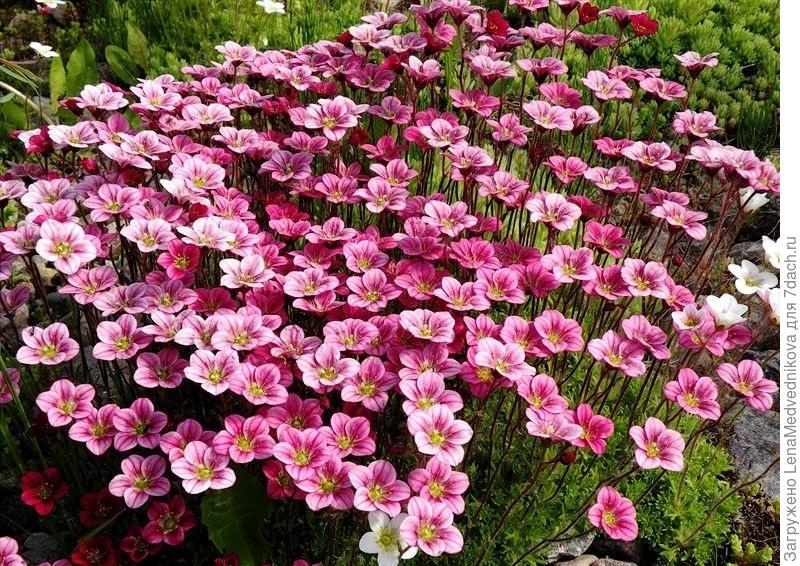
Arends' saxifrage in bloom. Photo from koffkindom.ru
Three-forked saxifrage
Three-forked saxifrage (Saxifraga trifurcata) forms a cushion only 5-7 cm tall. Carved leaves are light green in color, thick and juicy, forked at the end, crimson petioles. During flowering, many tall brown peduncles are put forward, at the ends of which white five-petal flowers bloom.
Three-forked saxifrage. Photo from the site fotki.yandex.ru
Saxifrage paniculata
Saxifrage paniculata (Saxifraga paniculata) or living ( Saxifraga aizoon) is somewhat reminiscent of young, thanks to the bluish leaves, covered along the edge with white teeth of limescale. Forms very beautiful rosettes only 5-6 cm in diameter, flowering occurs in June-July.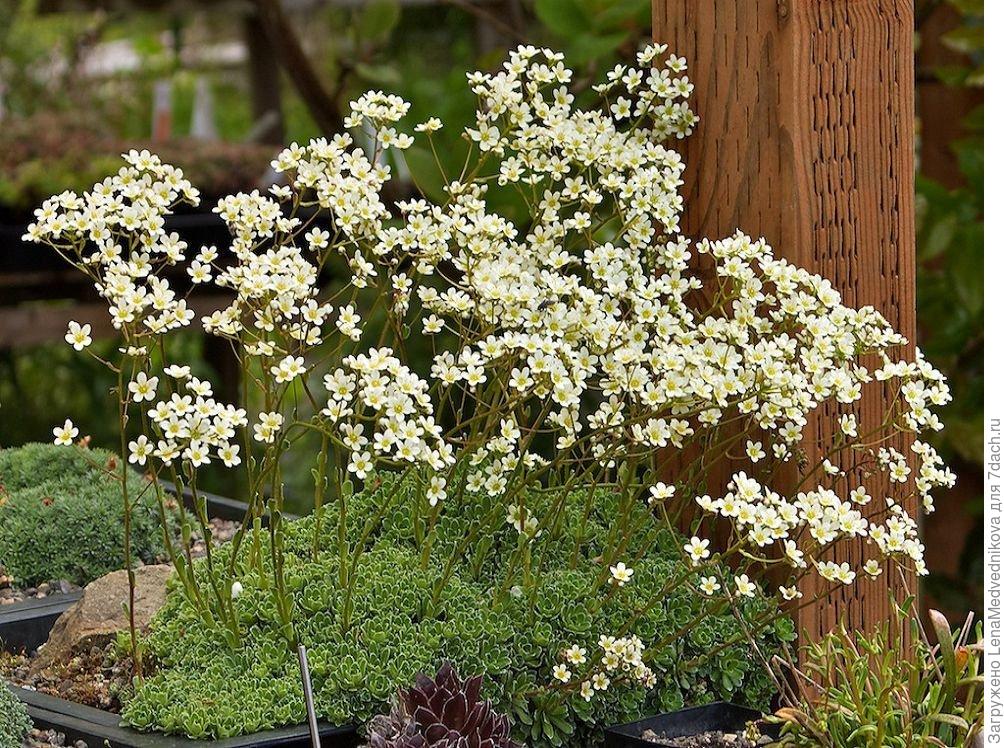 Saxifrage paniculata. Photo from zakupator.com
Saxifrage paniculata. Photo from zakupator.com
Varieties most interesting to gardeners:
- Macoch. Leaf rosettes up to 15 cm in diameter, white flowers with a yellow center, located on long (up to 50 cm) peduncles. Flowering time - from May to July.
- "Balcana minima" is an interesting and rather rare collector's variety. Plants form low cushions with tiny rosettes (1-2 cm in diameter).
Saxifrage shadow
Saxifrage shadow (Saxifraga umbrosa), another name for city (Saxifraga x urbium). Named for its ability to grow in shady areas. Forms a continuous carpet no higher than 10-15 cm. Evergreen spatulate leaves have teeth along the edge, interesting variegated forms are bred. Blooms in May-June.
Saxifrage shadow ‘Variegatum’. Ffrom the site kvetki-gorki.by
Plants of the variety "Aureopunctata" have green leaves, decorated with yellow spots, their rosettes are not more than 10 cm in diameter. Pink flowers with a purple center rise on high (up to 40 cm) peduncles. Flowering in May-June.
Saxifraga cortusolifolia
Saxifraga cortusolifolia (Saxifraga cortusifolia) has white flowers, blooming in September-October. Plant height 20-30 cm.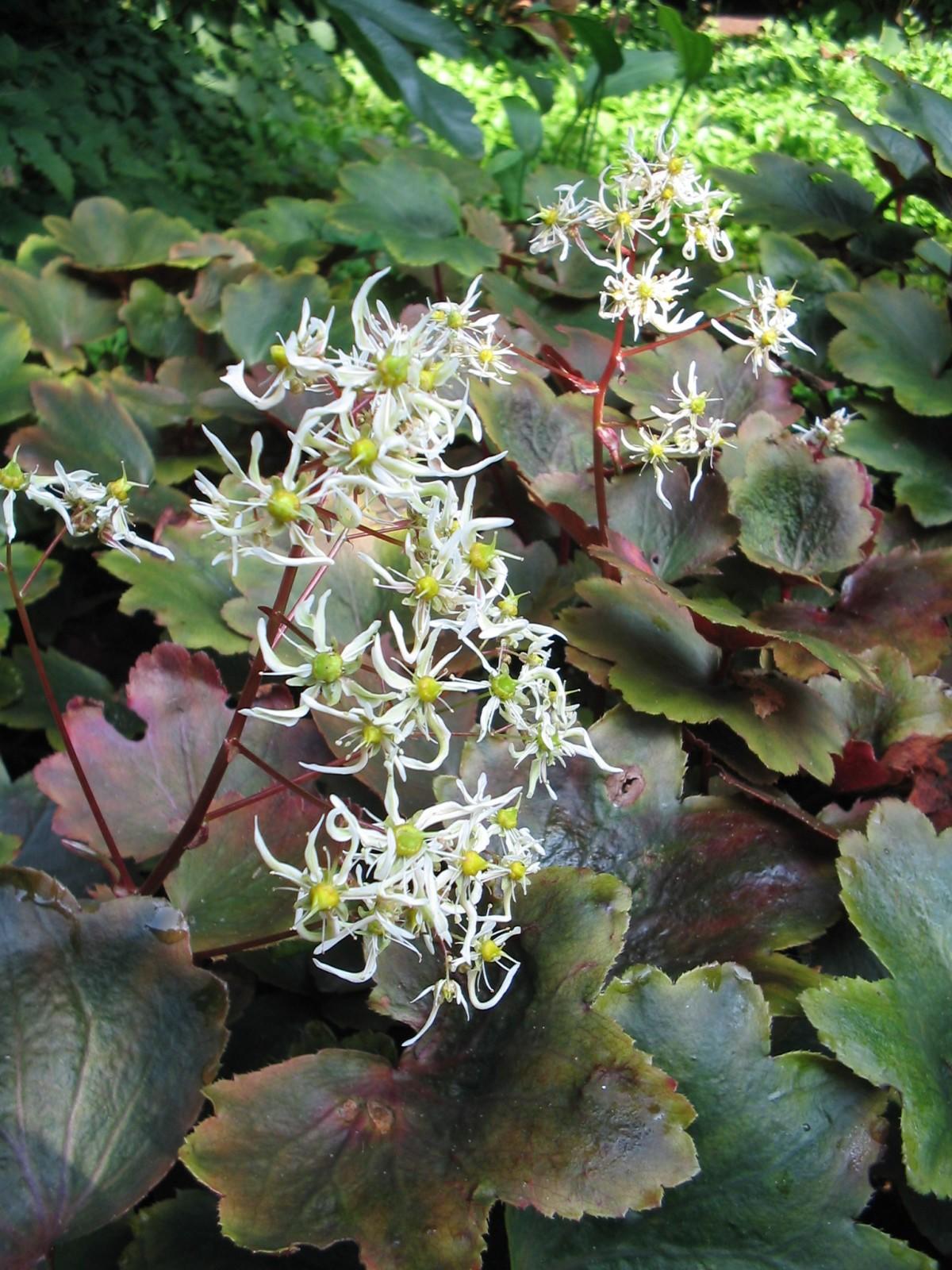
Saxifrage cortuzolifolia, grade "Rubrifolia". Photo from appeltern.nl
You should know that these plants are very sensitive to various plant residues getting on their pads. For example, if the leaves of trees fall on saxifrages, they will begin to rot.
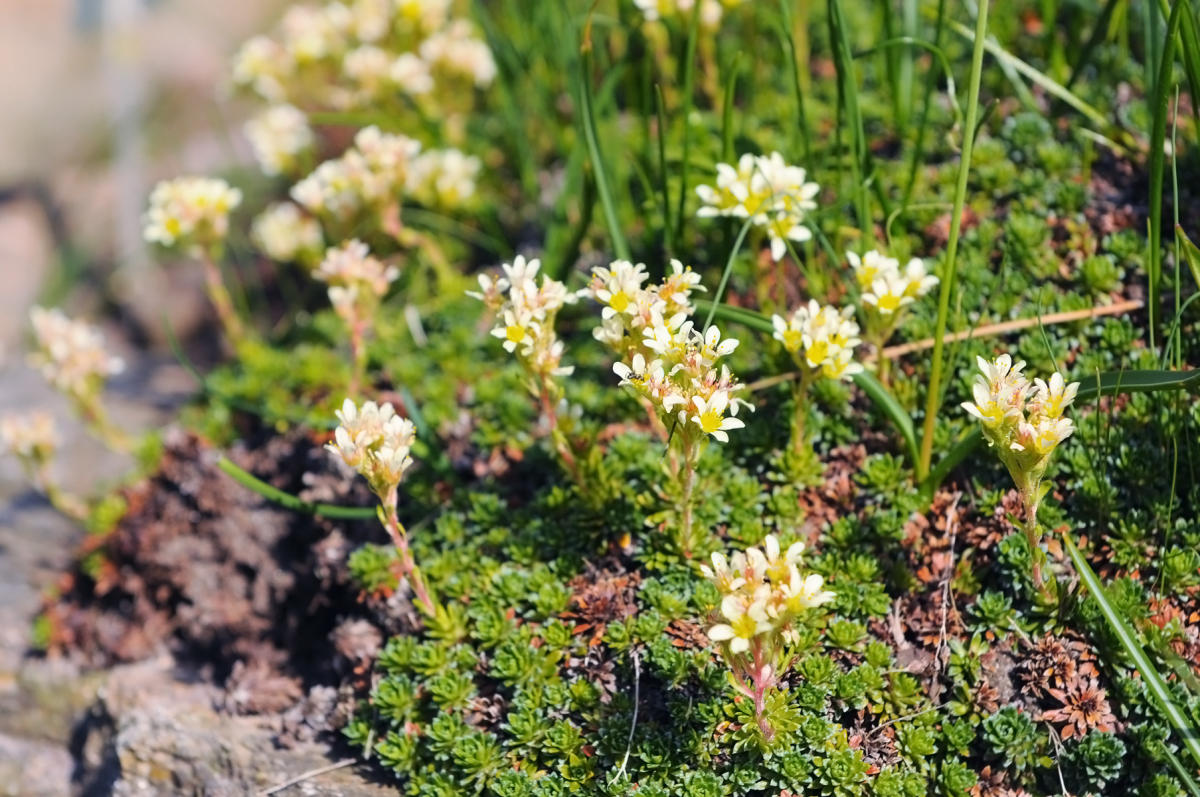
Mulching with light gravel is useful to retain moisture. It also protects the plants from overheating, and the root collars of the saxifrage from getting stuck. Species that require special conditions are grown by amateur collectors.
Vegetative propagation
Saxifrage easily propagated by dividing the bush in August. The bush is dug up and broken into several divisions, which are seated in new places.In June-July, some types of saxifrage, which form long side shoots, can be propagated by cuttings. Cut branches up to 10 cm long and plant them in loose peat-sandy moist soil, shade from above. Over the summer, the cuttings take root and form small independent rosettes, which are covered with a layer of leaves for the winter.
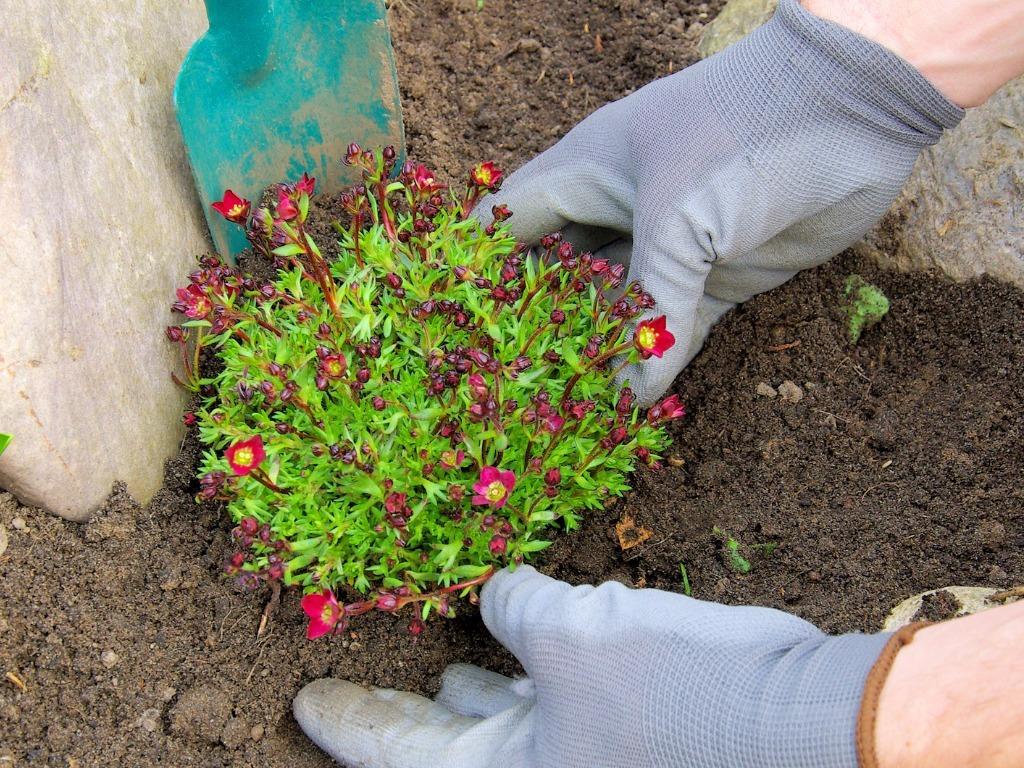
You can transplant plants into pots and put them indoors for the winter. The next year they are planted in the garden, and they will already bloom.
The saxifrages themselves reproduce by rooting layering. Their creeping shoots, when in contact with the ground, give roots and form new plants.
Reproduction by seeds
For propagation, fresh (maximum three-year-old) seeds are used. Since most species require stratification, it can be sown in open ground before winter or kept in the cold at home.Seeds (very small) are placed superficially on the soil and lightly sprinkled with sand. The box is covered with a film and put in the refrigerator for 3 weeks. By the way, some rare species require a longer period of cold.
After stratification, the crops are taken out and placed in a bright place. After 1-2 weeks, germination begins. When 2-4 true leaves appear, the seedlings dive into separate cups.

In May, seedlings are hardened by opening a window or taking them out into the street. In early summer, grown plants can be planted in the ground. In the first year, saxifrage will gain vegetative mass, and will bloom the next season. Some species may only take a year to germinate, so pots with unhatched seeds should be kept moist during this period until germination.
On sale are usually seeds of Arends saxifrage hybrids. They do not require special preparatory measures. Seeds are sown in March for seedlings or in early May immediately in open ground.
You can choose saxifrage seeds at our market, where you can find saxifrage seeds from different manufacturers.

